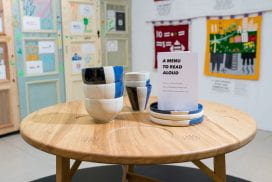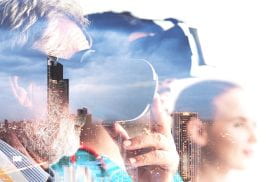‘Every night elderly dockers were in tears. Many in the audience had seldom or never been to a theatre. They shouted out in recognition, ignoring the shushing. It was recognition of the way of life they had known when there were still working ships in the heart of Bristol. Liverpool dockers on strike came down, and they told us they recognised every docking dodge and slang phrase.’
Playwright ACH Smith in WordSmith. A Memoir.
Last year, the University of Bristol Theatre Collection acquired the archive of Up the Feeder, Down the Mouth, a theatre production written by ACH Smith based on interviews with former dockers. First performed at Bristol Old Vic, the show’s success ensured a second run at M Shed on Princes Wharf with a large cast of professional and non-professional performers from a range of community groups and a set that included a ship, a train, and Bristol city docks themselves. As the promotional poster made clear (cover image), the real value of this production came from its roots in the everyday life of real dockers.
With generous funding from the Brigstow Institute’s Ideas Exchange, Dr Amy King (History) and Dr Jess McCormack (Theatre), specialists in oral history and verbatim theatre respectively, devised a collaborative project to work on this new archive with two student researchers. The successful applicants, Nate Thorpe (MA Immersive Arts) and Elisha Rodrigo (BA History), spent a few days in the archive, drawing on their expertise to think of ways to engage new audiences with the city’s dockside heritage through Up the Feeder, Down the Mouth, find ways to reflect the city’s broader identity in this important heritage space, and to uncover stories that are yet to be told.
As academic staff, we are encouraged to reap the benefits of interdisciplinarity – often interdisciplinary collaboration is a prerequisite of grant applications. But how often do students get the chance to collaborate beyond their discipline? And how could the experience of doing this work in our city empower students as interdisciplinary researchers?
Outcomes
Drawing on historical and creative methodologies, Nate and Elisha began by exploring the archive, pulling it apart to find the narrative threads it contains. They framed their investigation around the following questions:
- What is in the archive?
- Whose voices are missing, and what does that mean for future research projects?
- How might we reflect the process of recontextualising historic material in today’s Bristol through a creative soundscape with the potential to engage new audiences?
Having examined the archive, Nate and Elisha then worked towards creating a layered and polyphonic soundscape that voices the process of selection and omission inherent in the creation of historical narratives and archives. The three ideas they came up with sit clearly at the intersection of History and Theatre.
1. A locative non-linear soundscape

Figure 1: An annotated echoes map of a soundscape in Millennium Square
This immersive soundscape would capture different voices interacting with each other, intersecting in a loud and indistinguishable hubbub and mimicking the auditory experience of hearing fragments of conversation as you walk along the docks. Listeners could stop to listen to a particular detail or move through the space to experience the range of voices, perspectives, and languages that were brought to the City Docks by the international trading community.
2. Bus audio: Bristolians’ interactions with dockers
A spatialised audio track on board the historic bus at M Shed, this audio track would explore the ways dockers move between two worlds – home and the docks – imagining the interactions between dockers and the broader Bristol community as they make this transition.

3. Sounds of the docks as a social space
This would include multiple soundscapes edited, mixed, and layered together, which would ask listeners to reflect on how the docks have changed as a social space within the city. It would combine narration and audio to draw out the evolution of the space as a site for socialising.
Reflections
Elisha: When I first read the application for this project, I was quite intimidated by the different components Amy and Jess expected the researchers to address. I had never carried out research in such an independent way before, and my knowledge of Theatre was extremely limited. However, being in the final year of my undergraduate studies, and wanting to explore potential career avenues, I pushed myself to apply. I am so glad that I did!
As a young Historian, it was a great opportunity for me to apply my skills above and beyond my undergraduate essays. However, more than this the interdisciplinary aspect pushed my thinking beyond critical analysis, and into a space of creativity and imagination. I started the project with little understanding of what a soundscape was, but with Nate’s knowledge and experience, I soon found myself working in collaboration to create soundscapes of our very own. In return, I had the opportunity to guide Nate through the unfamiliar territory of archival material and encourage him to ask historical questions that are not as prominent within his own discipline of Theatre.
The freedom of independent research gave us the opportunity to pursue authentic avenues of inquiry that came from our own interests. Not only did this make the project even more enjoyable and engaging, but it really allowed us to put our heads together and produce ideas that took in aspects of both disciplines. Through a collaborative effort, we were able to take historical analysis and translate it into an immersive audio experience that made the history of Dockers much more accessible and relevant for today’s society.
This project really opened my eyes to the benefits of interdisciplinary work, and I would love to pursue similar avenues of work in the future. As a result of applying historical thinking to Theatre, I have begun to wonder how history can be interwoven with seemingly distant fields like science and technology. Moving forward, I would like to explore the possibility of interdisciplinary collaboration further as I finish my undergraduate degree and consider postgraduate study.
Nate: Working with archival material was a new experience for me, and despite how exciting it was, I felt completely lost when faced with the stacks of material to sort through. Having Elisha to guide me through was fantastic, as she was able to highlight connections between the information we were reading, and I began to feel confident in starting to draw my own with her support. The actual material we had was brilliant to look through; being able to hold the production papers from such a significant play to Bristol was eye-opening. As a Theatre student I gained a far greater insight into how much work was put in to create a performance of such magnitude, which would be difficult to learn otherwise.
To create soundscapes from this material I found myself having to adapt my normal way of working. As an Art/Theatre student, in most interdisciplinary practice I have done before I would typically create the content. However, with the dense collection of material to work with, I found that I was able to focus on style and medium as the actual narrative was provided from the archive itself!
Overall, this experience has introduced me to a new method of creation, by using verbatim and spoken word history as a basis for narrative, and developed my confidence to make artistic choices concerning how the narrative would be presented to the audience. Finally, learning how to delve into archives, and where to draw connections from both inside and outside the archive has me wanting more chances to explore history and heritage through theatre and performance.
Amy & Jess: It was fantastic to be in the archives with Elisha and Nate, who might not have met outside this project. The ideas they came up with drew their disciplinary knowledge together in exciting and innovative ways, playing to their strengths in their disciplines, and we can imagine every one of these three ideas working well in the cityscape. We’re really looking forward to meeting with M Shed along with Elisha and Nate to share these ideas.
As lecturers, we are both very interested in exploring possible ways to embed staff-student collaboration and interdisciplinary collaboration into the curriculum, so it was great to work with Elisha and Nate on this student-led research project and see some original creative outputs emerge from the process. The project has also highlighted appetite for future collaborations between History and Theatre, which we’re looking forward to pursuing within the curriculum.
The volume of applications we received for the student researcher vacancies reveals the intersection of History and Theatre as an existing area of interest among our students. Applicants had written historical scripts, researched Theatre history, or done sound design for historical documentaries, pointing to a rich but scattered community of theatre historians and history-focused theatre practitioners around campus. We’d like to try and bring students enthusiastic about theatre and history together. The undergraduate Theatre curriculum currently includes the second-year unit ‘Performing the Archive’ and the final-year unit ‘Site-specific and Immersive Performance’; it would be really exciting to explore the possibility of bringing staff and students from History and Theatre together to work on these units to produce both written reports and creative outputs as we explored with this project. We plan to discuss the possibility of encouraging more History students to take up the Creative Practice Dissertation to produce something for the stage, for example, and to explore the possibility of a joint honours degree programme in History and Theatre. We also plan to discuss about possibilities for the MA History and MA Immersive Arts students to work together on creative dissertation projects.




